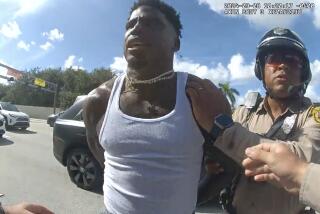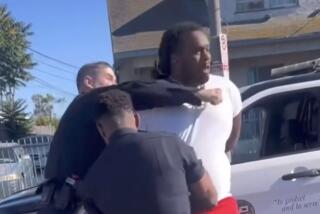Conflicts Persist in King Trial : Beating: Testimony differs over behavior of the motorist and the location and severity of the injuries he suffered at the hands of the officers.
- Share via
SIMI VALLEY — Midway through the Rodney G. King beating trial here, the battle between the prosecution and defense is being fought over several key questions that have been the subject of conflicting testimony and are not definitively answered by the now-famous videotape of the incident.
Among the questions are:
* Did the officers strike King repeatedly across the head with their police batons in a display of excessive force that could have been deadly?
* Was King combative after officers ordered him out of his car after a high-speed chase, or was he only making furtive movements to escape their blows?
* How serious were King’s injuries--and were they accurately chronicled in police reports that night?
After opening statements this month, prosecutors slowly built their case that King, although he was an ex-convict fleeing from police that night, did not deserve what happened when he stepped out of his Hyundai shortly after midnight on March 3, 1991.
“Whatever Rodney King was or whatever Rodney King did, it did not justify what you saw on this videotape,” Deputy Dist. Atty. Terry White told the jury.
White and his co-prosecutor, Alan Yochelson, chose not to call King to the stand, and instead presented two California Highway Patrol officers as their key witnesses against the four Los Angeles police officers accused in the beating.
Melanie Singer and her partner-husband, Timothy Singer, testified that after King was shot with Sgt. Stacey C. Koon’s electric stun gun, Officer Laurence M. Powell stepped in and struck the 26-year-old motorist half a dozen times in the head.
To dramatize what they saw, the prosecutors had the Singers step down from the witness stand and, with batons in hand, demonstrate what they called “power strokes” by swinging the metal weapons through the air in front of the jury.
The prosecution’s strategy throughout this testimony was to prove that the alleged blows to the head not only violated Los Angeles Police Department policy on the use of batons but were also unwarranted by King’s behavior.
Once the prosecution hadcompleted its evidence, the defense opened its case. Led by Koon’s attorney, Darryl Mounger, the defense brought in Officer David A. Love, who said he was standing behind Powell in the opening scenes of the videotape. He said that Powell struck King in the shoulder area, not the head.
Koon testified that he also saw no head shots and that instead, Powell and Officer Timothy E. Wind followed his orders and struck King only on the joints, such as the wrists and ankles.
To bolster their argument that King was not hit across the head with metal batons, Powell’s attorney, Michael Stone, showed the jury photographs of King soon after the beating. Bruises can be seen on his limbs, but not on his head.
Stone, Mounger and Paul DePasquale, the attorney for Wind, have sought to persuade the jury that all of the force used on King was within the prescribed guidelines of the Police Department.
“The evidence will be there were no head shots,” Stone told the jury. “And the evidence will be that officers are trained not to strike people in the head because such blows can be fatal.”
DePasquale said of his client, Wind: “He did what he was taught to do, which was to use the baton and the kicks that are department-approved.”
It has been precisely on that point--whether the blows and kicks conformed to LAPD policy--that another key issue has surfaced in the trial.
Prosecutors, using the videotape as their guide, have shown the jury the images of King rolling on the ground under a torrent of baton blows. When he is occasionally seen attempting to rise, prosecutors contend that he is only trying to deflect the blows or to get out from under their reach.
The defense interprets the videotape differently. Several officers, most notably Koon, testified that King repeatedly refused to lie face down on the ground so he could be safely handcuffed and instead tried several times to rise to his feet in what Koon said were attempts to “either escape or attack my officers.”
Defense attorneys have argued that King’s bizarre behavior, such as his laughing and dancing just moments before the beating began, led them to believe that the motorist was heavily intoxicated and probably under the influence of PCP.
But prosecutors have stressed that tests found no evidence of drugs in King’s system, although he was legally drunk.
In an interview last year with the district attorney’s office, King said he feared for his life and was trying to run away from the officers. But because he did not testify during the prosecution’s presentation--and because he also may not be called by the defense--the jury may be left only with a videotape that, ironically, is unclear in some respects.
Also surfacing as a key issue in the trial has been how badly King was hurt by the 56 blows captured in the 81-second amateur video.
Officers Susan Clemmer and Love, both of whom were at the scene, said King’s injuries appeared to be minor. Their testimony was bolstered by Koon, who wrote in his sergeant’s log that the motorist suffered mainly “a split lip,” caused when he fell to the pavement.
One of the charges against Koon is that he attempted to cover up the incident by filing a false report and trying to downplay the severity of King’s injuries. Earlier in the trial, Pacifica Hospital officials told prosecutors that the motorist suffered numerous facial cuts and bruises, and two broken bones.
The question of King’s injuries is critical for two reasons. Prosecutors contend that the officers kept striking him with no regard to the amount of pain he suffered. But the officers’ attorneys said that their clients repeatedly hit King because he did not respond to the pain by complying with their orders to lie down.
The jurors also will have to grapple with the question of whether some officers may be more culpable than others. So far, the most damaging evidence has been against Powell, who is also accused of filing a false police report. On one radio transmission introduced as evidence, Powell can allegedly be heard giggling just moments after the beating.
The fourth officer in the case, Theodore J. Briseno, distances himself from the other three defendants in the courtroom. On the videotape, Briseno is seen at one point grabbing Powell’s baton and pushing it away in what his attorney, John Barnett, said was an attempt to stop the beating.
But later on the tape, Briseno placed his foot on King’s neck or head area. Prosecutors called it a kick. Barnett said it was a department-approved stomp to hold King on the ground so he could be handcuffed.
On the tape, King’s head appears to recoil and, regardless of Briseno’s intentions, the baton blows by Powell and Wind continue.
More to Read
Sign up for Essential California
The most important California stories and recommendations in your inbox every morning.
You may occasionally receive promotional content from the Los Angeles Times.














